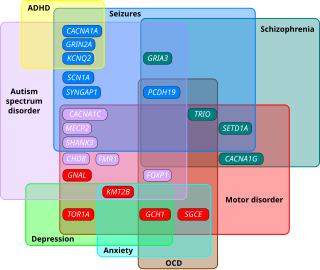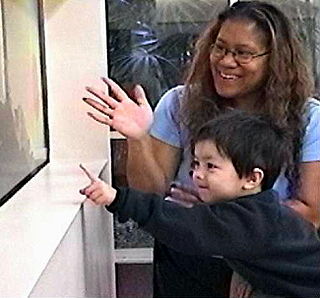
Asperger syndrome (AS), also known as Asperger's syndrome or Asperger's, is a diagnosis formerly used to describe a neurodevelopmental condition characterized by significant difficulties in social interaction and nonverbal communication, along with restricted, repetitive patterns of behavior and interests. Asperger syndrome has been merged with other conditions into autism spectrum disorder (ASD) and is no longer considered a diagnosis. It was considered milder than other diagnoses which were merged into ASD due to relatively unimpaired spoken language and intelligence.

Hyperlexia is a syndrome characterized by a child's precocious ability to read. It was initially identified by Norman E. Silberberg and Margaret C. Silberberg (1967), who defined it as the precocious ability to read words without prior training in learning to read, typically before the age of five. They indicated that children with hyperlexia have a significantly higher word-decoding ability than their reading comprehension levels. Children with hyperlexia also present with an intense fascination for written material at a very early age.

Savant syndrome is a phenomenon where someone demonstrates exceptional aptitude in one domain, such as art or mathematics, despite significant social or intellectual impairment.
Developmental disorders comprise a group of psychiatric conditions originating in childhood that involve serious impairment in different areas. There are several ways of using this term. The most narrow concept is used in the category "Specific Disorders of Psychological Development" in the ICD-10. These disorders comprise developmental language disorder, learning disorders, developmental coordination disorders, and autism spectrum disorders (ASD). In broader definitions, attention deficit hyperactivity disorder (ADHD) is included, and the term used is neurodevelopmental disorders. Yet others include antisocial behavior and schizophrenia that begins in childhood and continues through life. However, these two latter conditions are not as stable as the other developmental disorders, and there is not the same evidence of a shared genetic liability.
Diagnoses of autism have become more frequent since the 1980s, which has led to various controversies about both the cause of autism and the nature of the diagnoses themselves. Whether autism has mainly a genetic or developmental cause, and the degree of coincidence between autism and intellectual disability, are all matters of current scientific controversy as well as inquiry. There is also more sociopolitical debate as to whether autism should be considered a disability on its own.

Autism spectrum disorder (ASD) is a neurodevelopmental disorder that begins in early childhood, persists throughout adulthood, and affects two crucial areas of development: social communication and restricted, repetitive patterns of behavior. There are many conditions comorbid to autism spectrum disorder, such as attention deficit hyperactivity disorder, anxiety disorders, and epilepsy.
High-functioning autism (HFA) was historically an autism classification to describe a person who exhibited no intellectual disability but had some difficulty in communication, emotion recognition, expression, and/or social interaction. However, many in medical and autistic communities have called to stop using the term, finding it simplistic and unindicative of the difficulties some autistic people face.
The following outline is provided as an overview of and topical guide to autism:

Autism therapies include a wide variety of therapies that help people with autism, or their families. Such methods of therapy seek to aid autistic people in dealing with difficulties and increase their functional independence.
Social Stories were devised as a tool to help autistic individuals better understand the nuances of interpersonal communication so that they could "interact in an effective and appropriate manner". Although the prescribed format was meant for high functioning people with basic communication skills, the format was adapted substantially to suit individuals with poor communication skills and low level functioning. The evidence shows that there has been minimal improvement in social interaction skills. However, it is difficult to assess whether the concept would have been successful if it had been carried out as designed.

Societal and cultural aspects of autism or sociology of autism come into play with recognition of autism, approaches to its support services and therapies, and how autism affects the definition of personhood. The autistic community is divided primarily into two camps; the autism rights movement and the pathology paradigm. The pathology paradigm advocates for supporting research into therapies, treatments, and/or a cure to help minimize or remove autistic traits, seeing treatment as vital to help individuals with autism, while the neurodiversity movement believes autism should be seen as a different way of being and advocates against a cure and interventions that focus on normalization, seeing it as trying to exterminate autistic people and their individuality. Both are controversial in autism communities and advocacy which has led to significant infighting between these two camps. While the dominant paradigm is the pathology paradigm and is followed largely by autism research and scientific communities, the neurodiversity movement is highly popular among most autistic people, within autism advocacy, autism rights organizations, and related neurodiversity approaches have been rapidly growing and applied in the autism research field in the last few years.
Asperger syndrome (AS) was formerly a separate diagnosis under autism spectrum disorder. Under the DSM-5 and ICD-11, patients formerly diagnosable with Asperger syndrome are diagnosable with Autism Spectrum Disorder. The term is considered offensive by some autistic individuals. It was named after Hans Asperger (1906–80), who was an Austrian psychiatrist and pediatrician. An English psychiatrist, Lorna Wing, popularized the term "Asperger's syndrome" in a 1981 publication; the first book in English on Asperger syndrome was written by Uta Frith in 1991 and the condition was subsequently recognized in formal diagnostic manuals later in the 1990s.

Classic autism, also known as childhood autism, autistic disorder, (early) infantile autism, infantile psychosis, Kanner's autism, Kanner's syndrome, or (formerly) just autism, is a neurodevelopmental condition first described by Leo Kanner in 1943. It is characterized by atypical and impaired development in social interaction and communication as well as restricted, repetitive behaviors, activities, and interests. These symptoms first appear in early childhood and persist throughout life.
Autism, also called autism spectrum disorder (ASD), is a neurodevelopmental disorder characterized by symptoms of deficient reciprocal social communication and the presence of restricted, repetitive, and inflexible patterns of behavior. Autism generally affects a person's ability to understand and connect with others, as well as their adaptability to everyday situations, with its severity and support needs varying widely across the spectrum. For example, some are nonspeaking, while others have very proficient spoken language.
The relationship between autism and memory, specifically memory functions in relation to autism spectrum disorder (ASD), is an ongoing topic of research. ASD is a neurodevelopmental disorder characterised by social communication and interaction impairments, along with restricted and repetitive patterns of behavior. In this article, the word autism is used to refer to the whole range of conditions on the autism spectrum, which are not uncommon.
The opioid excess theory is a theory which postulates that autism is the result of a metabolic disorder in which opioid peptides produced through metabolism of gluten and casein pass through an abnormally permeable intestinal membrane and then proceed to exert an effect on neurotransmission through binding with opioid receptors. It is believed by advocates of this hypothesis that autistic children are unusually sensitive to gluten, which results in small bowel inflammation in these children, which in turn allows these opioid peptides to enter the brain.
Sex and gender differences in autism exist regarding prevalence, presentation, and diagnosis.
Nonverbal autism, also called nonspeaking autism, is a subset of autism spectrum disorder where the person does not learn how to speak. One study has shown that 64% of autistic children who are nonverbal at age 5 are still nonverbal 10 years later.
Social (pragmatic) communication disorder (SPCD), also known as pragmatic language impairment (PLI), is a neurodevelopmental disorder characterized by difficulties in the social use of verbal and nonverbal communication. Individuals who are defined by the acronym "SPCD" struggle to effectively indulge in social interactions, interpret social cues, and may struggle to use words appropriately in social contexts.
The diagnosis of autism is based on a person's reported and directly observed behavior. There are no known biomarkers for autism spectrum conditions that allow for a conclusive diagnosis.






